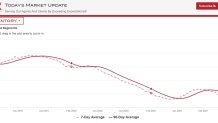Home foreclosures hit record lows these last two years thanks to COVID-19 relief, which was meant to prevent families from losing their homes during the pandemic.
But now, those foreclosure rates are creeping back up to the highest levels since March 2020.
That’s according to the January 2022 U.S. Foreclosure Market Report by ATTOM, licensor of the nation’s most comprehensive foreclosure data and parent company to RealtyTrac, the largest online marketplace for foreclosure and distressed properties.
The report shows there were a total of 23,204 U.S. properties with foreclosure filings, which includes default notices, scheduled auctions or bank repossessions. That number is up 29% from a month ago and 139% from a year ago.
Get DFW local news, weather forecasts and entertainment stories to your inbox. Sign up for NBC DFW newsletters.
Texas is among the top three states that saw the greatest increases.
The increase was expected by industry experts, as COVID-19 mortgage bailouts and foreclosure restrictions aimed at helping homeowners expired by the end of December.
“The increased level of foreclosure activity in January wasn’t a surprise,” said Rick Sharga, executive vice president of RealtyTrac, an ATTOM company. “Foreclosures typically slow down during the holidays in November and December and pick back up after the first of the year. This year, the increases were probably a little more dramatic than usual since foreclosure restrictions placed on mortgage servicers by the CFPB expired at the end of December.”
Local
The latest news from around North Texas.
Foreclosures are still far below normal levels. According to CNBC, September 2021 foreclosure actions were almost 70% lower than they were pre-pandemic.
“Despite the increased level of foreclosure activity in September, we’re still far below historically normal numbers,” said Sharga told CNBC. “Whether the increase is a prelude to a more serious problem, or just a return to normal levels of foreclosure is one of the bigger debates going on inside the industry right now.”
The upswing in people having issues making mortgage payments is clear, whatever those reasons may be.
“For whatever reason, they've stopped making their payments. So it's typically a loss of a job. Or in America, I think the highest percentage of bankruptcy is caused by medical bills,” said Mark Johnson, CEO of JPAR Brokerage of Texas.
Either way, all of those homes are being quickly absorbed into the hungry housing market.
"You know, it's never more important to talk with their financial and tax advisor and a real estate professional because 30% of homes are selling immediately in this market. And there's really no reason to go through any complicated process when you can sell the home quickly,” said Johnson.
And that's the thing local realtors are struggling with right now. Housing inventory is still very low this year and continues to drop.
That continued drop in inventory in Texas is very clear in JPAR’s weekly reports posted online:

Johnson said many of the issues experienced last year are spilling over into this year.
"It is a strong seller's market. In fact, homes keep selling and inventories keep dropping, while rents exceed the cost of buying,” he said.
Johnson said their data shows most homes are selling in a week or less. The strong demand stems from the continuous stream of people moving to Texas, supply chain and labor issues, rising costs in raw materials and a battle between millennials and baby boomers over available homes.
"There's 72 million Millennials in America, who are reaching their peak home-buying years," Johnson explained. "And then you have a wave of baby boomers -- there are 76 million baby boomers who are extending their work-life and not selling the family home. So, you put those two things together, along with some other factors, and there's just simply not enough homes for folks to buy."
Those in and around the retirement age have also taken advantage of lower interest rates to buy a second home and convert one of their properties into a vacation rental.
"It's totally adding to the inventory dry up when you think about it,” Johnson said. Many folks who maybe had their first home because of low interest rates, and they have decent income, are able to buy their next home but convert their prior home to a rental or a short term. It’s adding to the situation – then you add on to those institutional buyers from Wall Street that are competing with the everyday consumer. And that is just making the situation even worse."
All of these factors that have depleted the inventory have resulted in rising home prices. According to a new report from realtor.com, the median home price in DFW is now $400,000, up 14% from this time last year.
That has created an odd cycle where anyone looking to rent or buy a home in North Texas is having to face.
"The average payment in a median home is about 17% of income, yet rent is 25% of income – making the buy decision even more compelling for so many, including millennials. The challenge is that there are not enough houses for sale,” Johnson said.
Johnson said in the last few months there were 54,000 new builds around DFW, but realtors say that's still not enough.
"There's about 12.3 million new households in the United States that have been formed since 2012. But just 7 million new homes have been built. So you can see the gap that's causing this inventory shortage,” said Johnson.
He said it’s important for potential homebuyers to stay as strong as his team of realtors continue to grind through the housing frenzy.
“So the emotional toll of working with your client who's not getting what they want, and then you're doing all the work and not getting paid because they're only paid on commission,” he said. “The dynamic of everyone being frustrated is a very difficult thing. So we're doing a lot of self-care, a lot of internal [checkin-ins] like, Are you getting enough rest? Are you are you taking care of yourself?”
One of the agents recently wrote 30 offers across her various client base and didn't get one accepted.
“We need a miracle. Because if you and I had all the money in the world to go build as many houses, we could solve the world's problems. We just need to build a bunch of houses,” said Johnson.



